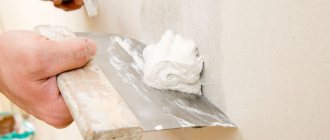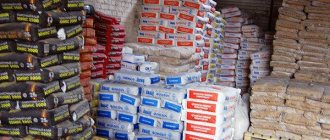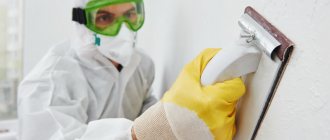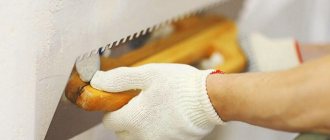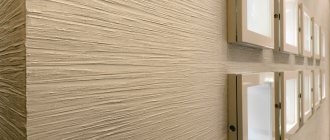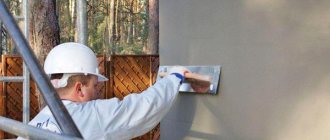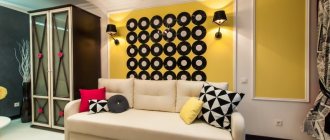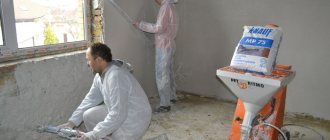13501 0 3
Icer November 15, 2016Specialization: master in the construction of plasterboard structures, finishing work and laying floor coverings. Installation of door and window units, finishing of facades, installation of electrical, plumbing and heating - I can give detailed advice on all types of work.
It is impossible to imagine puttying work without a spatula.
If you decide to do the rough finishing yourself, then you will need a good tool. Today I will tell you how to choose a spatula for putty, since the quality of work directly depends on this device. We will look at the main types of products and figure out what you should pay attention to when purchasing one or another option.
Different jobs require different sizes of spatulas.
How to choose a professional construction spatula for wall putty
A professional spatula for finishing putty on floors and walls must be steel. Here you can see the finishing putty for painting. Moreover, its thickness is no more than mm. Its fabric should bend and have maximum rigidity.
Disposable spatulas are easily recognized - they are complemented by a black plastic handle and a metal work area.
Its thickness should not be more than 0.5mm. Such a tool will begin to deform at the very minimum load, and it is extremely difficult to achieve smoothly even walls with its help. It does not level the surface, but only makes defects more noticeable, repeating and highlighting them against the general background.
Often on the market you can buy painting tools with a plate, which range in width from 80 to 450 mm. There are so many masters, so many opinions, and each one has different definitions of the most convenient spatula . The following sizes of spatulas for putty are distinguished on the market:
- classic, standard tool, which stands out with a width of 200 to 250 mm;
- additional, width from 80 to 100 mm;
- corner spatulas for putty, the prices of which also vary.
To process internal and external corners, it is rational to purchase professional spatulas. They are distinguished by two cavities located at an angle of 90 degrees.
For internal and external corners
Such spatulas are not in great demand because their operation requires mastering a certain technique, and the corners in the room must be even.
Many repairmen prefer not to spend extra money on buying special corner spatulas, and create them with classic variations.
Types of spatulas
The spatula got its name from the German language. This word means "scapula". In fact, the tool is just this simple device. A plate is attached to the handle, with the help of which plaster, putty and other similar compounds are applied and smoothed.
However, the spatula is suitable not only for these purposes. For example, in many of its varieties the plate is sharpened quite sharply, so it can be used to remove old wallpaper from the wall or to scrape off an old layer of paint. You can also use this tool to work with cement or masonry mortar - for example, when building a brick kiln.
The spatula is used for laying ceramic tiles and for many other operations where an even application of any viscous composition is required. Of course, such a variety of work cannot be performed with the same tool. There are several varieties of it, each of which has certain characteristics and serves specific purposes.
Facade
Already from the name it is clear that such a spatula is intended for working with building facades. Using this tool, plaster is applied to the wall from the street side. This kind of work has a peculiarity - as a rule, we are talking about fairly large areas. The second feature is the density of the plaster composition. It's not that easy to smooth out.
Taking these points into account, we can distinguish two main parameters of the façade trowel:
- size. It is clear that plastering a large wall with a small spatula can take a very, very long time. Therefore, the tool must be such that it can be used to immediately process a relatively large surface area. The size of facade spatulas usually varies from 40 to 60 centimeters. This length is optimal for this type of work. Of course, do not forget to focus on yourself personally - if you can hardly hold a 60-centimeter spatula in your hand, then the quality of work carried out with its help will not be too high;
- rigidity. Not only do you have to work with fairly dense material, but also the rather long length of the spatula contributes to sagging. Therefore, such a tool must have a high level of rigidity. The optimal material for the manufacture of façade trowels is carbon steel. It has high strength, so the spatula will not bend when you smooth the plaster along the wall with pressure. Which is exactly what is required.
When choosing this equipment, pay attention to its weight. It is clear that a rigid long blade made of durable material cannot be called light by default. But still the mass varies. It is very difficult to work with an excessively heavy tool for a long time. Therefore, this factor must be taken into account. Also pay attention to the handle. It should lie comfortably in your hand, not turn or slip out. The ideal option is a rubberized handle.
In principle, facade varieties can also be used to treat walls on the side of the room. But such a tool is not suitable for small areas. And for delicate work too. If, for example, it is necessary not to plaster a wall or ceiling, but to putty, then it is better to use another type of spatula.
Read also: How to unscrew the clutch on a Husqvarna chainsaw
Painter
A painting spatula is used not so much for repair work as for finishing work. With its help, for example, puttying is carried out - sealing all, even microscopic, holes on the surface of a wall or ceiling. Thus, a perfectly flat plane is created, suitable for further finishing.
Naturally, such work requires high-quality tools. In general, many people treat spatulas as some kind of disposable consumables - they buy the cheapest option and think that it’s just for one time, and then it’s not a pity to throw it away. In fact, this approach is fraught with very low final quality of the work performed. Poorly performed puttying will certainly affect all subsequent finishing.
Therefore, you need to take your choice seriously. Yes, you can do just one renovation in your life and never touch putty or plaster again. But a high-quality spatula can easily be used for further use. For example, it does an excellent job of mechanically cleaning surfaces of anything.
When selecting, the main attention should be paid to the blade. It should be flexible and springy, but not excessively. The ideal material for its manufacture is stainless steel. It is very easy to clean from all the compounds with which the work was carried out. In addition, this metal is strong and quite durable, not to mention corrosion resistant.
The shape of the blade can be trapezoidal or rectangular. The width also varies: there are both narrow long spatulas and short wide ones. The latter are much more convenient, since the application of finishing materials with their help is faster and of better quality. As for the shape, be guided by your taste. Their only difference is that it is more convenient to remove the finishing mixture from the bucket with a rectangular spatula. And the trapezoidal one will not scrape off the remains from its walls, for example.
Serrated
A notched trowel is structurally very similar to a paint trowel: the same handle, the same spatula, but the latter has square teeth cut out along its entire length. The main purpose of the tool is to apply an adhesive composition. The presence of teeth makes it possible to make a perfectly even layer. The end of the blade is pressed close to the wall, and the voids between the teeth form strips of glue that are absolutely equal in thickness.
This application is optimal for the subsequent installation of any finishing material: ceramic tiles, linoleum, carpet, drywall, etc. You should choose a specific tool model based on the required thickness of the adhesive layer and the material with which you will work in the future:
- large and sparsely spaced teeth are designed for applying glue under drywall and porcelain tiles;
- medium-sized teeth (height 6 mm) are well suited for laying ceramic tiles;
- Small and frequently spaced teeth help apply adhesive under carpet and other floor coverings.
You can also apply a decorative pattern to the plaster using a serrated tool. The effect is quite interesting and aesthetic. This approach is often used by finishing craftsmen.
When selecting a serrated model, you should focus on the same parameters: the quality of the handle and blade. Don't forget to consider the size of the teeth. There are varieties on sale that are a spatula without a handle. There are teeth on both sides of it: larger on one, smaller on the other. This makes the tool universal, since it can be used to apply adhesive under both tiles and drywall. But use is somewhat difficult due to the lack of a handle. If you plan to work with large areas, then it is better to buy two or three normal, comfortable spatulas than one universal one.
Rubber
A rubber spatula is a small tool designed for decorative work. Basically, it is used to grout seams on tiles, scratches on laminate flooring, etc. Thanks to the softness of the rubber, you don’t have to worry about damaging the finishing material. A steel tool will not be suitable for this type of work, since, for example, the tile will eventually be scratched.
There are no special requirements for choosing such a tool. The models differ from each other mainly in size. Choose the one with which you will be most comfortable working. Naturally, for narrow short seams it is better to take a smaller spatula.
Angular
This variety is designed for forming corners - both internal and external. But nowadays such a tool is used less and less. Firstly, it is only suitable for initially right angles. Sharp and dull cannot be aligned with it. Secondly, many different corners made of plastic or aluminum are now sold. Their use is much simpler than tedious leveling using plaster or putty compounds.
Figured
This type of spatula is more of a design tool than a repair tool. It is designed to work with liquid wallpaper or plaster. The pattern applied to the blade makes it easy to give the surface an original texture. The result looks very aesthetically pleasing, and the work is very simple.
As you can see, in order to choose the right spatula, you just need to know for sure what purpose you need it for. Each type of repair and finishing work requires the use of appropriate tools, which should be relied upon. Good luck!
In accordance with applicable law, the Administration disclaims any representations and warranties that may otherwise be implied and disclaims liability in relation to the Site, the Content and its use. More details: https://seberemont.ru/info/otkaz.html
Was the article helpful?
Tell your friends
Kinds
A good spatula for puttying walls is used to perform a variety of construction and repair work. Here is the cost of puttying walls for wallpaper. To make a tool plate, the manufacturer uses different materials.
They often opt for metal, plastic or rubber. Today on the market you can buy spatulas that are used for highly specialized purposes.
To process the load-bearing surface, it is rational to use products with a flat surface, a holder made of plastic or wood and a metal plate.
The material discussed in the article varies, so its price will be based on the manufacturer and type of material used.
Facade
Despite the fact that this tool is called that, it can be used not only for processing facades, but also for interior finishing of load-bearing structures.
A professional spatula for putty is distinguished by a more massive blade, which is made of strong steel; it cannot be deformed during operation.
Using such a tool, you can easily apply the construction mixture to the surface to be treated. In its shape, the working surface resembles a quadrangle with two parallel and two non-parallel sides, with a width of thirty cm or more.
Facade
Facade tools are most often used simultaneously with painting tools. If the layer of putty will be applied with one solid ball, it is more convenient to collect the building mixture from the container with a more compact analogue. Depending on the size of the ball, the consumption of finishing putty per 1 m2 will depend.
At the stage of applying the last ball, the spatula is used as an additional element. The construction mixture is placed on it, and using a painting spatula, it is scooped up in small portions and applied to the surface.
Painter
For finishing, it is more rational to use a paint spatula. Using it you can perform the following manipulations:
- make the surface as smooth as possible after applying the putty material;
- mask the seams between the plasterboard layers. Here we talk about puttingtying drywall for painting;
- earn defects and notches;
- handle complex structures.
Like the façade spatula, it has a trapezoidal shape and is complemented by a plastic handle.
Painter
But despite the structural identity, the painting tool stands out with the following differences:
- the minimum width of such a spatula is 20 mm;
- thickness. The plate of the painting tool is, as a rule, thinner than that of the façade analogue;
- level of elasticity. The tool is distinguished by a more elastic and bendable blade;
- material. For the production of paint spatulas, alloy steel is used, which is resistant to corrosion due to the chromium content, while the other analogue under consideration is made from steel with a carbon content of over 0.6%.
Painting tools are divided into the following types:
- for professional and non-professional work;
- those that can be used once.
Metal scraper
If you still don't know which spatula to choose for putty, don't forget to buy a scraper.
It has a narrow scope of application and is used to remove excess building material from the surface.
Scraper
Its feature is considered to be the thickest blade possible, which does not deform; it is made of strong metal. This spatula has a relatively small width, equal to 50 mm.
Rubber
Most often it is used for rubbing seams. It is a single piece of rubber that comes in different types and shapes and is used to cover scratches and dents in fiberboard flooring.
But basically, such a spatula is purchased for grouting the seams of tiles, while during work you don’t have to worry about its integrity.
Rubber
Rubber can never affect the quality of the tiles, no matter how hard you clean them. The spatula perfectly follows all the unevenness and roughness of the surface, so it is ideal for grouting joints.
For tiles
This type of spatulas is not particularly distinguished by its wide range. They can be divided only by a couple of characteristics: the size of the teeth, which are used to determine the ball of glue used, as well as the shape. The larger the ball, the longer the putty dries. The latter differs only in width.
In the first case, a spatula with a width of 20 cm is used, in the second the width may be larger. Such differences can be characterized by different areas of application.
Tools with teeth are used when working with small-sized rectangular wall plates made of baked clay, and a falcon-shaped tool is used for massive slabs that decorate floor and wall coverings.
For tiles
Regarding the height of the teeth, the following standard sizes are available on the market: 0.6, 0.8, 1, 1.2, .4 mm . If you need a larger tool, then purchase a classic spatula.
The thickness of the layer of tile adhesive (here is its composition) may increase if it is simultaneously applied to both the facing surface and the tile. But only the directions of application of the material should be opposite.
When working with rectangular putty plates, you should also pay attention to the rubber spatulas that are used to rub the seams. By the way, they are used as putty spatulas for cars, which also vary in width.
Classic sets of such tools consist of several types of spatulas. They are considered semi-professional, and working with them is extremely tedious. Most likely, it is more rational to use them for processing small-sized objects and for large-sized tiles.
Main sizes
Any modern spatula for puttying walls has a handle and a plate, where the quality of finishing and leveling the surface is affected by the evenness of the edge. Various materials can be used to produce the plate, such as plastic, rubber or metal.
The entire variety of tools on the market can be divided into the following categories:
- Professional - equipped with a one-millimeter plate, the material of which does not allow it to bend under light loads;
- Non-professional – experienced craftsmen call such models disposable. Externally, they have a black plastic handle and a thin plate no more than half a millimeter thick.
The main criterion for a high-quality spatula is the rigidity of the blade, due to which the tool should correct irregularities, and not repeat them !
As for the sizes of spatulas, the following indicators are considered standard parameters:
- Width - paired with a facade spatula, the width of the canvas will be 30-45 centimeters, the best size for a painter will be 10-15 centimeters. For wall finishing, models with a canvas width of 2-80 centimeters are usually used, with versions up to 8 centimeters used for working in hard-to-reach places. It will not be possible to accurately treat the entire wall with a narrow spatula, since the tool will begin to follow the curves of the surface being treated.
Read also: Grounding instead of the neutral wire
Stacked models are called products with a width of 10-25 cm, since they make it easy to transfer the putty to a working spatula. Tools with a blade up to 30 centimeters make it possible to process small surfaces.
It is best to correct the surface of curved walls, correcting rough and large irregularities, using large spatulas, the width of which is at least 300 millimeters!
60-centimeter products are used for starting putty , when the material is applied in a thick, rough layer.
- Length – depends on the type of work to be done and is selected individually! A tool that is too short, just like a tool that is too long, will not be a good solution. So, a blade that is too long will simply sag when finishing walls, having a bad effect on the final result.
If you do not consider yourself to be a professional finisher, then you should not purchase a spatula wider than 40 centimeters - without certain knowledge and experience it is quite difficult to work with such a tool!
Putty Tool Dimensions
To process walls, it is rational to choose the tools required in terms of dimensions.
Wide for leveling
To level an uneven base and easily putty the walls, use:
- wide type for facades (up to 600 mm);
Wide
- rule (1500–3000 mm).
Rule
Thanks to this, it is possible to eliminate the most severe and massive defects. They are used to apply the so-called initial putty mixture, and the material is applied in as thick a layer as possible.
Is it convenient to putty with medium
Medium putty tools (with a width of 150 to 250 mm) are used to process large irregularities and dents that remain after the initial treatment.
This spatula allows you to create the smoothest putty layer possible. The main task of such a spatula is to fill holes and eliminate visible defects.
Average
After processing, the spatula may leave minor protrusions, which are removed after complete drying using special ribbed paper.
Narrow for puttying
Narrow (50–100 mm) is suitable for processing minor depressions that remain after using the previous material. After its use, there are practically no flaws left on the surface.
Narrow
It is irrational to use this tool to make the surface as smooth as possible, because it fully replicates all the chaotic irregularities on the walls. At the same time, it is often used to treat hard-to-reach areas. With this material you can take the mixture from a container and apply it to the work surface.
Choosing a tool for applying finishing putty
In order not to get completely confused in the presented options and to purchase a product that will perform the assigned tasks, we recommend that you pay attention to such characteristics. First of all, you should pay attention to the handle.
It should be comfortable, and it is better if there are no flaws or sharp protrusions on the surface of the metal. If they appear during the work process, this indicates that you are about to purchase a low-quality product.
Do not purchase items that are too long or narrow. They will be inconvenient to use during operation, while they are extremely difficult to operate.
To level the surface, it is more rational to purchase a product that is shaped like a trapezoid. Tools in the form of triangles or droplets are not so convenient.
Shaped like a triangle
Moreover, they performed poorly during operation. The blade of the working tool should be smooth, at the same time moderately flexible, and not deform with minimal pressure.
Ceramic brick is a material that has been successfully used in construction and renovation for a long time. Here are the pros and cons of this brick.
Putty can almost perfectly level the surface, as well as make it strong and durable. Here you will find out how long the putty takes to dry.
Crushed stone is mined by crushing rocks and metallurgical waste. By clicking on the link, you will become familiar with the characteristics of the flakiness of crushed stone.
If, while pressing on the blade, it begins to bend strongly during operation, the construction mixture will roll off such a spatula, and it will even be difficult to apply it to the wall, not to mention leveling it. Spatulas with excessive rigidity will undoubtedly become deformed during operation.
The correct spatula should be equipped with a blade that will spring slightly when pressed. To apply the finishing putty, you can use a tool whose blade is made of stainless steel.
This will make it easy to clean after work and will ensure there is no corrosion that will negatively affect the finish. A spatula with an iron blade and metal coating is considered a low-quality product and requires the utmost care to prevent the formation of rust.
It can negatively affect not only the material, but also the treated surface. Pay attention to the blade. There should be no sharpening points on it; it is rational to use such products for other types of work.
For more information about choosing a spatula, watch the video:
Care instructions
Even the highest quality instrument without proper care will quickly become unusable. This statement is also true for spatulas. In order for the product to last a long time, it must be properly cared for:
- After completing the work, the blade and handle must be thoroughly washed and dried;
- Do not put a large amount of heavy mixtures on the blade or expose the blade to excessive mechanical loads;
- It is advisable to prevent the blade from coming into contact with abrasive surfaces;
- It is better to store spatulas in an upright position, hanging them on hooks or nails. When stored in boxes with other tools, there is a high risk of bending the blade of the product, after which the tool will become unusable.
It is almost impossible to repair a broken spatula, and therefore, if the tool breaks, it would be best to buy a new one.
We hope that the instructions given in the article will help you choose a high-quality and reliable tool, optimal for use in the type of repair and finishing work that is planned to be carried out. The video that concludes the material will clearly tell you about the key points of choosing and using a construction spatula in the repair and decoration of premises.
How to clean the tool
There are many videos and articles on this topic on the Internet. But these two options are considered to be the most common.
- make a couple of slits in a tin can, and in the end you will have an accessible and effective device for cleaning tools;
- arm yourself with a wet rag (to prevent dust from appearing) and an ordinary washcloth to clean scale from stainless utensils.
For effective cleaning, you just need to delicately treat the contaminated surface with iron filings.
It is rational to use a wet rag to brush away falling dust particles. After a few minutes of manipulation, the instrument will look like new.
In this way, even old, long-hardened putty can be easily cleaned. Some people recommend using sandpaper, but it can damage the delicate surface of the spatula. This method can only be used by professionals who know how to control the intensity of friction.
